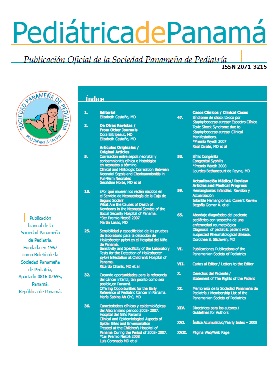Clinical, epidemiological characteristics, diagnosis and treatment of pediatric patients with histoplasmosis at the Hospital Materno Infantil José Domingo de Obaldia, since January 2008 to December 2018
Authors
DOI:
https://doi.org/10.37980/im.journal.rspp.20201701Keywords:
Histoplasmosis, Histoplasma capsulatum, hepatomegaly, splenomegalyAbstract
Introduction: Histoplasmosis is a disease caused by the Histoplasma capsulatum fungus, first described by Samuel Taylor Darling in a worker in the Panama Canal area. Exposure to the fungus is common in tropical and subtropical areas, most are asymptomatic or slightly symptomatic (self-limited) infections. Pediatric patients are more vulnerable to severe forms of histoplasmosis, especially under two years. Materials and methods: A retrospective cross-sectional study was carried out in patients diagnosed with histoplasmosis at the José Domingo de Obaldia Maternal and Child Hospital from January 2008 to December 2018. Results: 8 cases were analyzed in 11 years (2008-2018), mostly of the male sex (n = 5). The main age group affected were those under 2 years of age (n = 7). The clinical features found were hepatomegaly and splenomegaly in all patients, in addition, fever, lymphadenopathy, anorexia, and asthenia. In the complementary studies thrombocytopenia was found in all cases, followed by anemia and leukopenia, in addition to alveolo-interstitial infiltrate on the chest radiograph of 6 patients. The diagnostic method was histopathological studies in bone marrow aspirate. The treatment used was amphotericin B, followed by Itraconazole. Of the 8 patients, 6 died with a lethality of 75%. Conclusions: It is a rare entity in our institution. It has a high lethality, the most vulnerable being those under 2 years. Patients presented disseminated infection data. Histoplasmosis should be suspected in patients with hepatomegaly, splenomegaly, thrombocytopenia, anemia and / or leukopenia.
Downloads
Published
Issue
Section
License
Copyright (c) 2020 Infomedic InternationalDerechos autoriales y de reproducibilidad. La Revista Pediátrica de Panamá es un ente académico, sin fines de lucro, que forma parte de la Sociedad Panameña de Pediatría. Sus publicaciones son de tipo gratuito, para uso individual y académico. El autor, al publicar en la Revista otorga sus derechos permanente para que su contenido sea editado por la Sociedad y distribuido Infomedic International bajo la Licencia de uso de distribución. Las polítcas de distribución dependerán del tipo de envío seleccionado por el autor.






